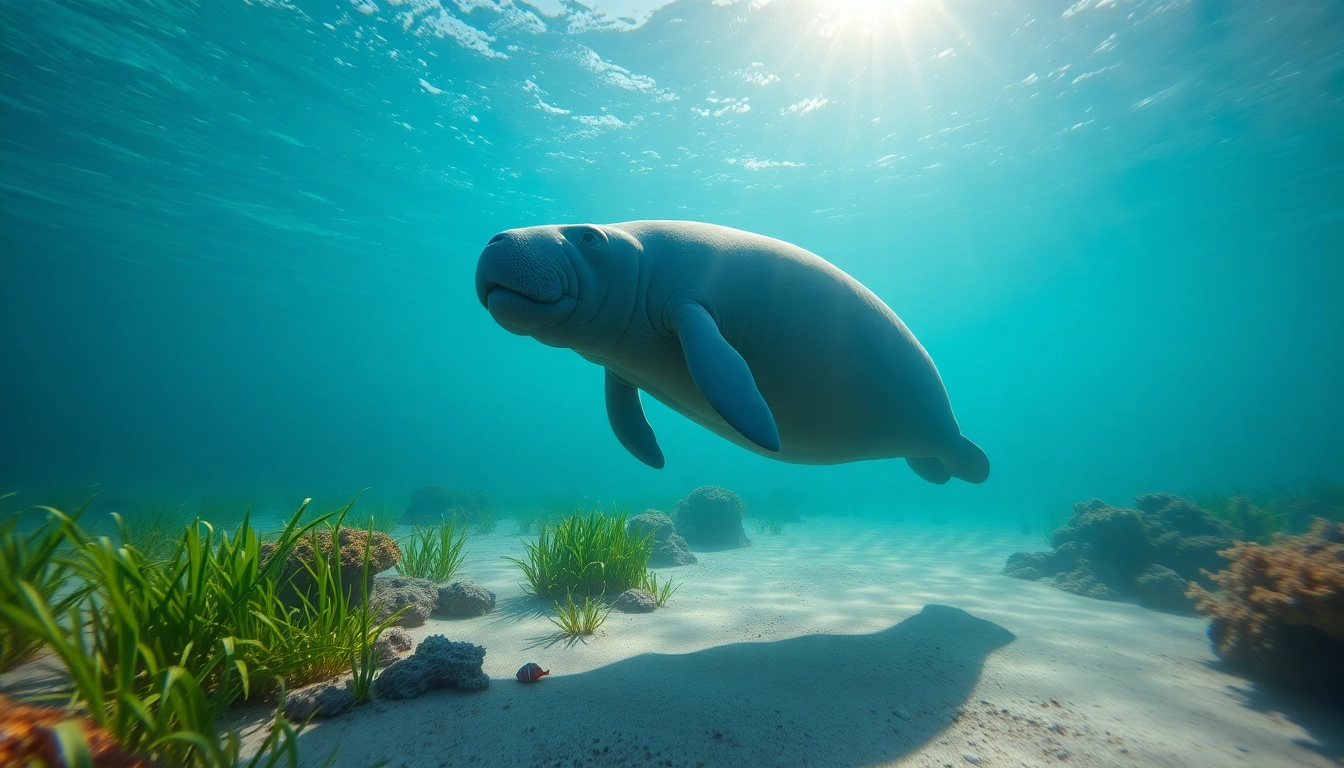Understanding Manatees Puerto Rico
Manatees, often referred to as “sea cows,” are gentle marine mammals that inhabit various coastal and freshwater environments around the globe. The Caribbean manatee, a subspecies of the West Indian manatee, is particularly found in the warm waters of manatees puerto rico, contributing to the biodiversity and ecological balance of this unique island. Understanding their characteristics, habitats, and the threats they face is crucial for promoting awareness and conservation efforts.
The Species: Characteristics and Habitats
The Caribbean manatee (Trichechus manatus) has several distinctive features that make it unique among marine mammals. They can grow up to 13 feet in length and weigh as much as 1,300 pounds. Their bodies are characterized by a large barrel-shaped torso, a paddle-shaped tail, and flippers equipped with nails for maneuverability in shallow waters.
Manatees are herbivores, primarily feeding on seagrasses and aquatic plants, which they graze on in shallow coastal regions and inland waterways. In Puerto Rico, mangroves, lagoons, and river systems provide ideal habitats for these gentle creatures. They are known to inhabit areas such as Condado Lagoon, the Manatí River, and various sections of the southern coast.
Why Manatees are Endangered
Despite their peaceful nature, manatees face significant threats that have led to their designation as a vulnerable species. Human activities such as urban development, pollution, and boating are substantial contributors to their declining population. Boat strikes are one of the leading causes of manatee injuries and deaths, as these animals often swim in shallow waters where boats operate.
Habitat loss due to coastal development also poses a significant threat. Seagrass beds, their primary food source, are depleted by poor water quality and harmful algal blooms, exacerbated by agricultural runoff and urban waste. Climate change further complicates the situation, impacting water temperatures and leading to the destruction of their natural habitats.
Conservation Efforts in Puerto Rico
Efforts to conserve and protect manatee populations in Puerto Rico have gained momentum, especially in light of their vulnerability. The Caribbean Manatee Conservation Center plays a crucial role in rescue, rehabilitation, and education efforts. The center not only cares for injured manatees but also conducts research and outreach programs to raise awareness about the species.
Local organizations are working tirelessly to establish protected areas where manatees can thrive without the threat of human interference. Initiatives include promoting regulations to reduce speed limits in manatee-populated waters, creating awareness campaigns to inform boaters of safe practices, and involving the local community in conservation activities.
Best Locations to See Manatees Puerto Rico
For those hoping to encounter these magnificent creatures in their natural habitat, there are several prime locations throughout Puerto Rico. Each site offers unique experiences and is vital for observing manatees in the wild.
Condado Lagoon: A Close Encounter
Condado Lagoon, located in San Juan, is one of the most accessible spots for manatee sightings. Despite being situated in an urban setting, the lagoon is a peaceful oasis where manatees often surface to feed and breathe. Kayaking or paddleboarding along the lagoon provides an intimate experience with these gentle giants. Visitors can often see them grazing on the seagrass beds that thrive in this calm waterway.
The best time to visit is during the early morning or late afternoon when the water visibility is optimal, and manatees are more actively feeding. However, it is essential to approach these animals responsibly, maintaining a safe distance and avoiding any disturbances.
Manatí River: Natural Habitat Exploration
The Manatí River, located on the northern coast of the island, offers a more natural setting for observing manatees. The river’s lush mangroves and freshwater estuaries create a serene environment ideal for these slow-moving mammals. Wildlife enthusiasts often embark on guided eco-tours to explore the river’s diverse ecosystems, where manatees can frequently be spotted in their natural behaviors.
If you visit, be sure to take along binoculars for a closer view of these majestic creatures from a safe distance. Guided tours not only enhance your chances of spotting manatees but also provide a wealth of knowledge about the local fauna and flora.
Best Viewpoints for Manatee Watching
Aside from Condado Lagoon and the Manatí River, several other locations around Puerto Rico offer exceptional viewpoints for manatee watching. Locations like Crash Boat Beach, known for its beautiful coastline, can also be a viable site for spotting these magnificent creatures. Keep an eye on local reports or talk to residents to find out where manatee sightings have recently occurred.
Another popular spot is near Puente Dos Hermanos, where paddleboarding enthusiasts have reported spotting manatees off to the lagoon side, especially at high tide. It is advisable to check with local resources for updated information on the best times and places for viewing.
Activities Involving Manatees Puerto Rico
Participating in activities that involve manatees is not only entertaining but also educational. These experiences can deepen respect for marine life and highlight the importance of conservation.
Guided Tours and Eco-Tourism
Guided tours focusing on manatee watching are highly recommended for those who want a fully immersed experience. Many eco-tourism companies operate in Puerto Rico, offering dedicated manatee tours that provide opportunities to see these creatures safely while learning about their habitats and the challenges they face.
Guides often discuss the significance of the manatee population in Puerto Rico, emphasizing conservation efforts and responsible interaction. Participating in these tours supports local economies and promotes sustainable practices that benefit wildlife.
Snorkeling Adventures with Manatees
Often regarded as one of the most thrilling ways to interact with manatees, snorkeling allows visitors to observe these creatures in their underwater environment. Certain tours in Puerto Rico offer one-of-a-kind experiences to swim alongside manatees while learning about their behavior and ecology.
It’s essential to choose tours that prioritize the safety and well-being of the manatees, as interaction should always be non-invasive. Many tours include educational components to ensure participants understand the importance of respecting marine ecosystems and the creatures within them.
Kayaking Through Manatee Habitats
Kayaking is another excellent way to immerse oneself in the habitats frequented by manatees. Paddling through calm waters not only provides a low-impact way to encounter marine life but also allows for quiet observation. Participants can easily navigate areas rich in seagrass and aquatic plants, which attract manatees.
As always, it’s critical to paddle with caution and respect the animals’ space. Involve yourself with guides who specialize in eco-friendly kayaking practices to enhance your experience and contribute positively to the environment.
Local Insights and Tips for Manatee Watching
To ensure a successful and rewarding experience while observing manatees in Puerto Rico, consider these local tips and insights that can enrich your understanding and respect for wildlife.
Best Times of Year to See Manatees
Manatees can be spotted year-round in Puerto Rico. However, the best times to observe them are during the warmer months when water temperatures are higher, and food sources are abundant. Morning and late afternoon are ideal periods, as manatees are more likely to surface during these times, engaging in feeding and social behaviors.
Be mindful of weather patterns; rainy seasons may affect water clarity and visibility, making sightings less reliable. Planning your trip during the right season can significantly enhance your chances of witnessing manatees in action.
Respecting Manatee Habitats: Dos and Don’ts
Respecting the natural habitats of manatees is critical to their survival. Here are some essential dos and don’ts:
- Do maintain a respectful distance. Approaching them too closely can stress these gentle animals.
- Do observe quietly without splashing or making loud noises.
- Don’t feed or touch manatees; human interaction can be harmful to their well-being.
- Don’t disturb their natural behaviors; always prioritize their comfort and safety.
Being a responsible visitor not only benefits the manatees but also enhances the overall experience for everyone.
Connecting with Local Conservation Groups
Connecting with local conservation groups can provide invaluable insights and additional opportunities to engage with manatees positively. Organizations focused on marine conservation often host events, workshops, and volunteer opportunities that focus on protecting manatees and their habitats. By getting involved, you can contribute to ongoing conservation efforts and learn from experts who are dedicated to preserving these beautiful creatures.
These groups can offer educational resources, updates on manatee populations, and ways to advocate for stronger protections for marine ecosystems in Puerto Rico.
Frequently Asked Questions about Manatees Puerto Rico
Where to Spot Manatees Safely?
Spots like Condado Lagoon, the Manatí River, and various coastal regions are popular for safe manatee watching. Always choose locations where manatees are known to visit and ensure that you’re following guidelines that support their safety.
What to Bring When Manatee Watching
When planning a manatee watching trip, consider bringing the following items:
- Binoculars for distant viewing
- A camera with a zoom lens (ensure that flash is turned off)
- Water, sunscreen, and a hat for protection from the sun
- Comfortable clothing and shoes suitable for water activities
Legal Regulations Regarding Manatee Interactions
In Puerto Rico, strict regulations are in place to protect manatees. It is illegal to harass, touch, or feed them, as well as to approach them too closely while boating or kayaking. Ensure that you are aware of and comply with local laws and guidelines while enjoying your manatee watching experience.



